口译中笔记法重点符号汇总
- 格式:doc
- 大小:153.50 KB
- 文档页数:17
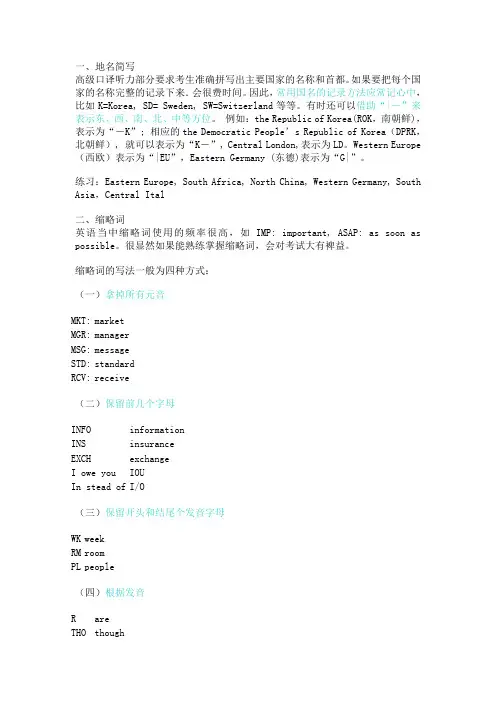
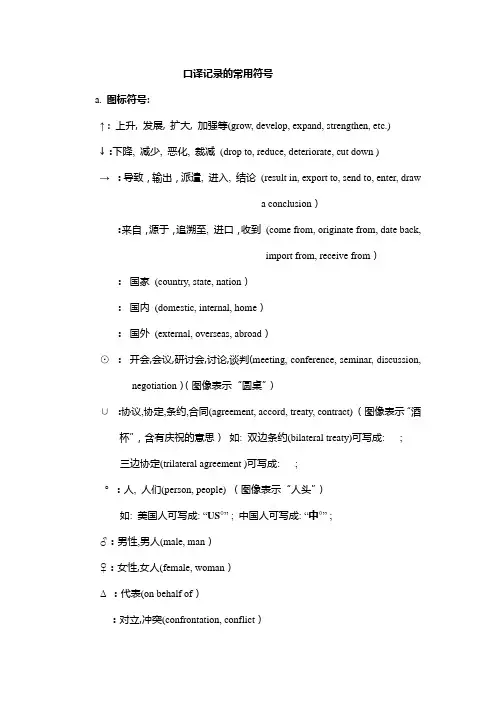
口译记录的常用符号a.图标符号:↑ : 上升, 发展, 扩大, 加强等(grow, develop, expand, strengthen, etc.)↓ :下降, 减少, 恶化, 裁减(drop to, reduce, deteriorate, cut down )→ :导致,输出,派遣, 进入, 结论(result in, export to, send to, enter, drawa conclusion):来自,源于,追溯至, 进口,收到(come from, originate from, date back,import from, receive from):国家(country, state, nation):国内(domestic, internal, home):国外(external, overseas, abroad)⊙:开会,会议,研讨会,讨论,谈判(meeting, conference, seminar, discussion, negotiation)(图像表示“圆桌”)∪:协议,协定,条约,合同(agreement, accord, treaty, contract) (图像表示“酒杯”,含有庆祝的意思)如: 双边条约(bilateral treaty)可写成: ;三边协定(trilateral agreement )可写成: ;°:人, 人们(person, people) (图像表示“人头”)如: 美国人可写成: “US°” ; 中国人可写成: “中°” ;♂:男性,男人(male, man)♀:女性,女人(female, woman)Δ:代表(on behalf of):对立,冲突(confrontation, conflict)~ :交流,交换, 相互(exchange, replace, each other)?:疑问,问题,提问(doubt , problem, question, ask): :说,告诉,认为,声明,例如(say, speak, tell, think, declare, such as, like)( ):包括,在…之中/内,封闭(including, within, among, inside, seclusion)∈:属于,归于,归属(belong to ,be part of, fall into, pertain to)// :停顿,停止,终止(stop, halt)& :和,与…一起(and, together with)…:等等(and so on, and so forth, and the like, etc.)√:正确,好,肯定的,积极的,同意(correct, good, affirmative, certain, positive, agree)×:不/非,错误的,坏的,不好的, 否定的(not, no, wrong, incorrect, bad, notorious, negative)☆:杰出的,优秀的,最佳的,重要的,榜样(outstanding, excellent, best, important, model)(星光璀璨,表示“优秀,突出”):高兴,开心,愉快,兴奋(happy, pleased, delightful, joyful, excited)(这是个脸谱图像符号,嘴巴向上翘,表示“开心”):不满,生气,不开心,郁闷(unsatisfied, angry, unhappy, gloomy)(嘴巴向下撇,表示“不高兴”):惊讶,惊奇,吃惊,震惊(surprised , astonished , amazed, shocked )(嘴巴张大,表示“吃惊”):害怕,恐惧,恐慌(scared , frightened, panic ) (两只眼睛张大,表示“恐惧”):听说,据说,众所周知(it is said that, maybe you’ve heard of, as we allknow , as is known to all ) (脑袋上画个耳朵,表示“听说过,有所闻”)b .数学符号:= :等于,相当于,是…的对手(equal to, the same as, a match/rival/competitor for sb.)≠:不等于,不同,不是…的对手(not equal to, different, no match for)≈:大约,左右(approximately, around, or so )>:大于,多于,超过,优于(greater, larger or more than, better than, surpass, superior to)<:小于,少于,不够,劣于,次于(smaller/fewer/less than, worse than, inferior to)+ :加上,另外,除此之外(plus, add, moreover, besides, in addition to, furthermore)-:减去,扣除,缺乏(minus, deduct, lack )∑:总共,合计(total, in all, add up )% :百分比,百分之…(percent)‰:千分比,千分之…(per thousand)∵:因为, 由于(as, because, owing to, due to, thanks to)∴:所以, 因此, 因而(consequently, so, therefore, as a result)c .常用缩写词:UN ( United Nations ) :联合国UNESCO (United Nations Educational, Scientific and Cultural Organization):联合国教科文组织UNICEF (United Nations International Children's Emergency Fund):联合国儿童基金会UNHCR (United Nations High Commissioner for Refugees):联合国难民公署EU (European Union ) : 欧洲联盟(简称“欧盟”)EEC (European Economic Community): 欧洲经济共同体NATO (North Atlantic Treaty Organization): 北大西洋公约组织APEC (Asian Pacific Economic Cooperation): 亚太经济合作组织WTO (World Trade Organization): 世界贸易组织WB (World Bank): 世界银行IMF(International Monetary Fund):国际货币基金组织L.G( ladies and gentlemen):女士们、先生们TKS( thanks):谢谢Org(organization):组织Co.(Company):公司MKT(market):市场L/C(letter of credit):信用证Ltd.(Limited): 有限Memo (memorandum): 备忘录 B.C.(before Christ): 公元前e. g. (for example): 例如i.e. (that is ): 即;那就是etc. (and so on ):等等esp.(especially):特别;尤其usu.(usually):通常;惯常max.(maximum): 最高min.(minimum): 最低;最小Wt.(weight):重量Kg.(kilogramme):公斤;千克b. (billion ): 十亿m.(million, meter, mile):百万;米;英里t.( thousand ,temperature , ton):千; 温度; 吨h. (hundred, hour, height): 百;小时;高度km. (kilometer)千米:公里sq. km (square kilometer):平方公里E(East):东S( South):南W( West ):西N( North ):北Q.( question ) :问题; A.(answer, acre ): 回答;英亩C (centigrade): 摄氏温度F( Fahrenheit): 华氏温度att. (attention):注意cf.(compare):比较c/o(care of): 转交ref.(reference):参考add.(Address):住址st.(street): 街std.(standard): 标准econ. (economy):经济ad.(advertisement):广告w (world):世界p (peace):和平r (repetition):重复y (year):年m (month):月w (week):星期 d (day):日a.m.(before noon):上午p.m.(afternoon):下午CN(China):中国(或简写为“中”) US(United States ):美国F(France):法国J(Japan):日本(或简写为“日”) UK(United Kingdom):英国HK(Hong Kong):香港MO(Macao):澳门TW(Taiwan):台湾AL(Australia ):澳大利亚SD(Sweden):瑞典SZ(Switzerland):瑞士CIS (Commonwealth of Independent States):独联体IQ(Iraq):伊拉克IR(Iran):伊朗ID(India):印度IN(Indonesia):印度尼西亚PL(Palestine ):巴勒斯坦PK(Pakistan):巴基斯坦d .综合性符号:. d ( yesterday): 昨天.. d (the day before yesterday): 前天. y( last year): 去年.. y (the year before last ): 前年d . (tomorrow): 明天 d .. (the day after tomorrow): 后天y . (next year): 明年y .. (the year after last): 后天[注:在年、月、日缩写词前后加“.” , 表示时间的推前或后移。

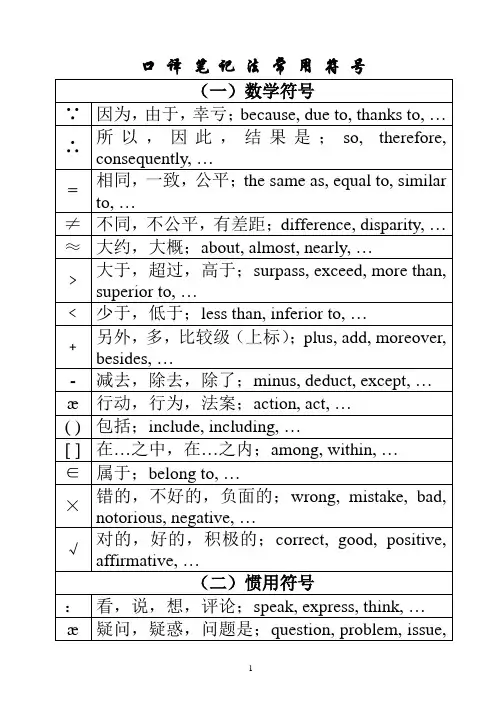
口译笔记法常用符号inquiry, interrogate, ask, mystery,…问题;question, problem, …!危险,警告,当心,值得注意的是;dangerous, warning, alarm, watch out, of course°人,人民,伙伴,朋友;people, partner, …✉信息,消息,情报;information, message, intelligence, …删除,废除,放弃;delete, discard, give up, …ഗ贸易,交换,交流,关于,关联,替代;trade, exchange, communication, relationship__ 这个,强调;emphasize a certain word/ phrase.…继续,持续,不断的,长期的,各种各样的,多的;more, continuous, …=> 加强,推动,促进;enhance, promote, …×#不仅;not only, …& 和,而且;and…@关于;aboute.g.例如,比如;for example, such as, …(三)图形符号☺高兴,激动;happy, pleased, excited, …☹失望,不满意,生气;unhappy, unsatisfied, angry, …会议,聚会;conference, symposium, convention, session, forum, seminar, council, congress, meeting, assembly, gathering, committee,commission, association, union, senate, parliament, convocation, …学校,大学,教育机构;school, college, educational institution, …医院,医疗机构;hospital, medical institution, …○全部的,整个的,所有的,完整的,彻底的;complete, whole, …目标,目的;aim, objective, target, …ര看到,注意到;see, notice, watch, …ര重视,强调;pay attention to, highlight, …□国家,民族;nation, state, republic, kingdom, federal, union, …国际,世界;international, world, …∧领导,顶点,顶级,最高级(上标);top, peak, leader, boss, king, governor, mayor,…国家领导人,政府首脑;state leader, …出口;export, …进口;import, …△城市,都市;city, urban, metropolitan, cosmopolitan, …▽农村,乡村;village, rural, country, countryside, farm, suburb, outskirt, …☆重点,重心,重视,重要的,主要的,杰出的;important, significant, remarkable* 特征,特点,代表;feature, characteristic, quality, nature, trademark, on behalf of…♀女性;woman, female, …♂男性;man, male, …V 胜利,凯旋;victory, triumph, …﹩美元,钱;有钱的,富裕的;dollar, money, rich, well-off, …∪协议,决议,合约,条约;agreement, treaty, contract, compact, convention resolution结束,停止,完成,实现;halt, stop, complete, …‖渠道;channel, tunnel, tube, pipe, ditch, duct, …发展;development, advancement, …开放;opening, …∟过去;in the past, long before, past time, …∟将来;in future, in the future, …↓影响,效果,压力,负担;influence, effect, affect, pressure, stress, burden, load,…(四)趋向符号←邀请,需要,访问,来到;be invited, needed, come (here), …→去,到,走;to, go (there)…↑增加,提升,提高,升级,升值;increase, improve, enhance, grow, lift, promote…↓减少,下降,降低,贬值;decline, decrease, reduce, degrade, lower, diminish, …(五)英文字母y 年;year M 月;month改编自吴钟明. 《英语口译笔记法实战指导》.武汉大学出版社。
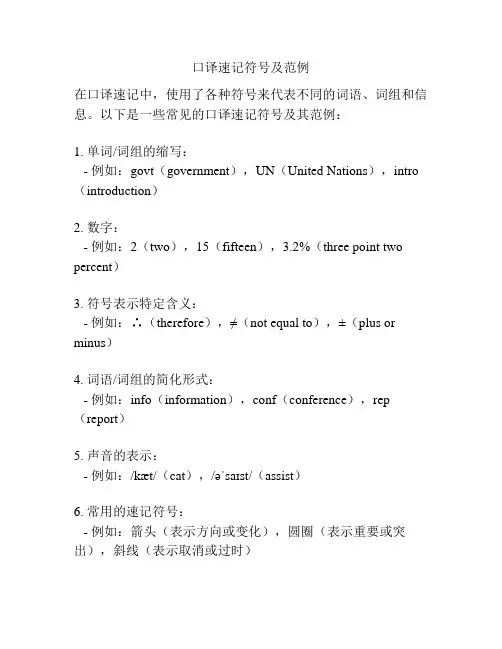
口译速记符号及范例
在口译速记中,使用了各种符号来代表不同的词语、词组和信息。
以下是一些常见的口译速记符号及其范例:
1. 单词/词组的缩写:
- 例如:govt(government),UN(United Nations),intro (introduction)
2. 数字:
- 例如:2(two),15(fifteen),3.2%(three point two percent)
3. 符号表示特定含义:
- 例如:∴(therefore),≠(not equal to),±(plus or minus)
4. 词语/词组的简化形式:
- 例如:info(information),conf(conference),rep (report)
5. 声音的表示:
- 例如:/kæt/(cat),/əˈsaɪst/(assist)
6. 常用的速记符号:
- 例如:箭头(表示方向或变化),圆圈(表示重要或突出),斜线(表示取消或过时)
7. 符号的组合和结构:
- 例如:↑(上升),↓(下降),→(发展),←(反对)
8. 表示固定短语或俚语的符号:
- 例如:BFF(best friends forever),TGIF(Thank God it's Friday)
请注意,以上仅为一些常见的例子,实际上口译速记符号有很多种,各口译员可能会根据个人习惯和需求进行一些定制或修改。
使用哪些符号以及如何使用符号,都取决于个人风格和技巧。
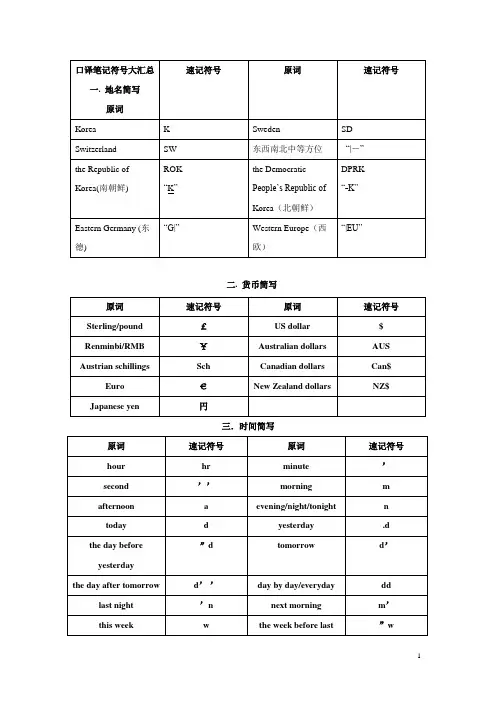
二. 货币简写三.时间简写四.度量衡五. 缩略词六.较长单词的处理办法七.字母、图像、符号一、缩略词英语当中缩略词使用的频率很高,如IMP: important, ASAP: as soon as possible。
很显然如果能熟练掌握缩略词,会对考试大有裨益。
缩略词的写法一般为四种方式:F拿掉所有元音MKT: marketMGR: managerMSG: messageSTD: standardRCV: receiveF保留前几个字母INFO informationINS insuranceEXCH exchangeI owe you IOUIn stead of I/OF保留开头和结尾个发音字母WK weekRM roomPL peopleF根据发音R areTHO thoughTHRU through二、字母、图像Z 表示"人"people/person,因为"Z"看上去像个人头,它通常被写在一个词或符号的右上角。
例如:日本人:JZ。
C 表示政府,统治:government,govern 希腊字母C读/ga:ma/,近似government, 所以就用C来表示govern, government。
governmental official 可以表示为 CZP 表示政治:politics, political希腊字母P读/pai/,近似politics, political。
那么politician就可以表示为 PZE 表示总数:total, totally, entire, entirely, on the whole, all in all, to sum up, ect. E 数学符号表示总值。
G 表示效率:efficient, effective。
G为效率符号。
Q 表示"通货膨胀":inflation因为这个符号酷似一个上升的气球。
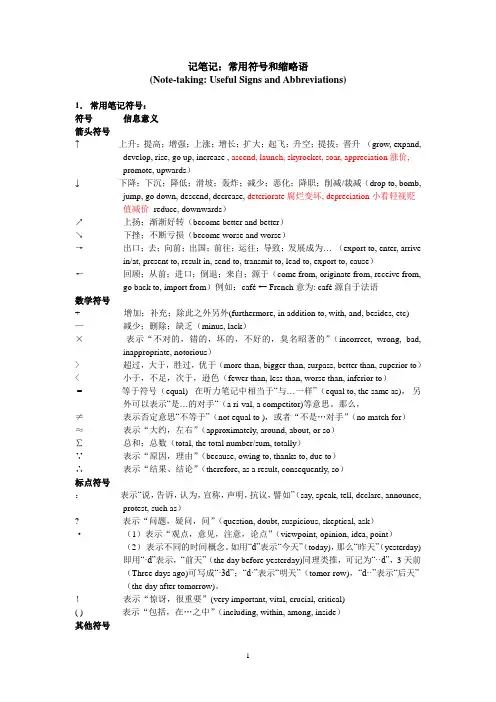
记笔记:常用符号和缩略语(Note-taking: Useful Signs and Abbreviations)1.常用笔记符号:符号信息意义箭头符号↑上升;提高;增强;上涨;增长;扩大;起飞;升空;提拔;晋升(grow, expand, develop, rise, go up, increase , ascend, launch, skyrocket, soar, appreciation涨价,promote, upwards)↓ 下降;下沉;降低;滑坡;轰炸;减少;恶化;降职;削减/裁减(drop to, bomb, jump, go down, descend, decrease, deteriorate腐烂变坏, depreciation小看轻视贬值减价reduce, downwards)↗上扬;渐渐好转(become better and better)↘下挫;不断亏损(become worse and worse)→出口;去;向前;出国;前往;运往;导致;发展成为…(export to, enter, arrive in/at, present to, result in, send to, transmit to, lead to, export to, cause)←回顾;从前;进口;倒退;来自;源于(come from, originate from, receive from, go back to, import from)例如:café← French意为: café源自于法语数学符号+ 增加;补充;除此之外另外(furthermore, in addition to, with, and, besides, etc) —减少;删除;缺乏(minus, lack)×表示“不对的,错的,坏的,不好的,臭名昭著的”(incorrect, wrong, bad, inappropriate, notorious)> 超过,大于,胜过,优于(more than, bigger than, surpass, better than, superior to)< 小于,不足,次于,逊色(fewer than, less than, worse than, inferior to)= 等于符号(equal) 在听力笔记中相当于“与…一样”(equal to, the same as),另外可以表示“是…的对手“(a ri-val, a competitor)等意思。

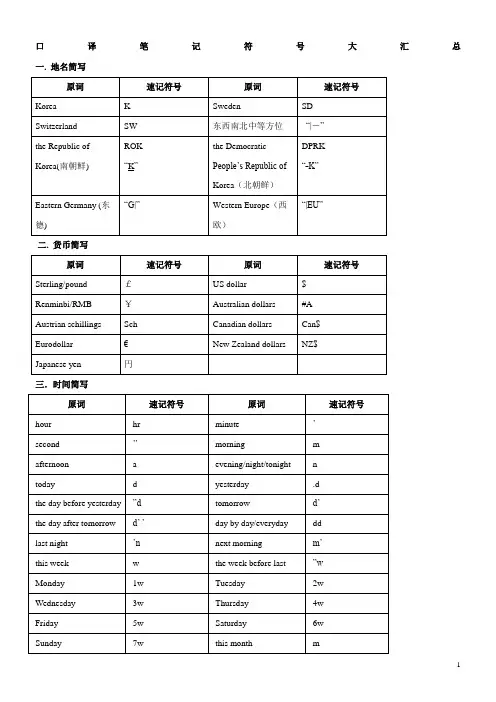
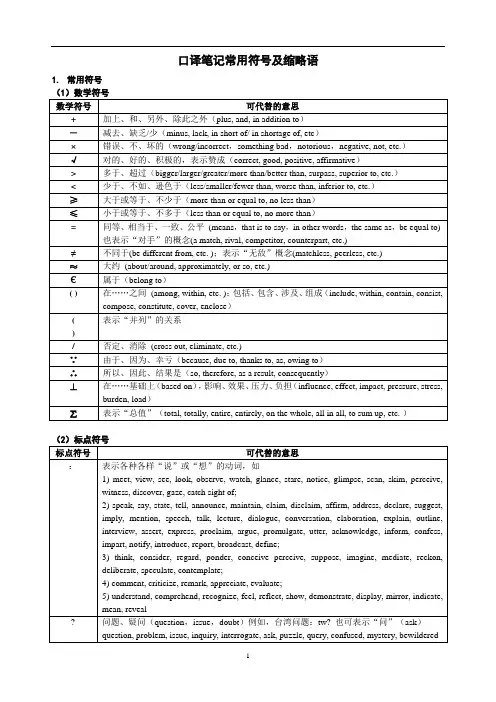
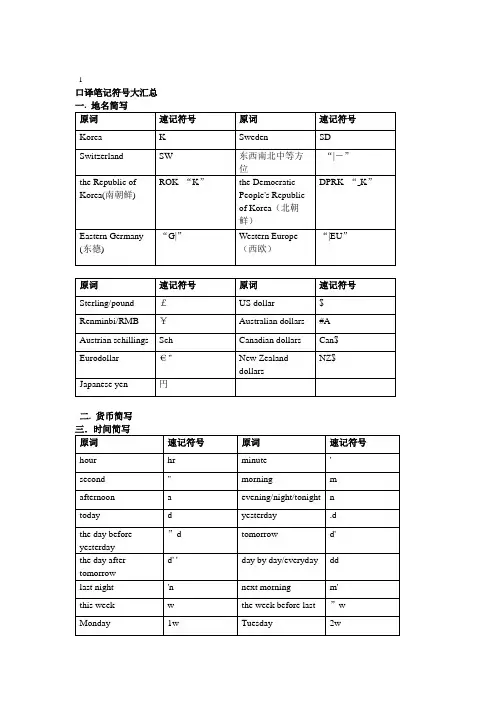
1口译笔记符号大汇总二. 货币简写2年底49 20年以后20y| century C since/ever since ┠uo to now/ until ┫in. centimeter cm foot ft minimeter mm knot kt mile mi acre A nautical mile nm五. 缩略词34You U Your UR Will WL WeekWKWeightWT-ism m socialismSm -tion n standardization (标准化) stdn -cian o techniciantecho -ing g marketing (市场营销) MKTg -ed d accepted acptd -able/ible/ble bl available avbl -ment mt amendment amdmt -ize z recognize regz -fulflmeaningfulmnfl七.字母、图像、符号568二、字母、图像Z 表示人people/person,因为Z看上去像个人头,它通常被写在一个词或符号的右上角。
例如:日本人:JZ。
C 表示政府,统治:government,govern 希腊字母C读/ga:ma/,近似government, 所以就用C来表示govern, government。
governmental official 可以表示为CZP 表示政治:politics, political希腊字母P读/pai/,近似politics, political。
那么politician 就可以表示为PZE 表示总数:total, totally, entire, entirely, on the whole, all in all, to sum up, ect. E 数学符号表示总值。
G 表示效率:efficient, effective。
口译笔记符号大汇总一. 地名简写原词速记符号原词速记符号Korea K Sweden SD Switzerland SW东西南北中等方位“|-”the Republic of Korea(南朝鲜)ROK“K”the DemocraticPeople’s Republic ofKorea(北朝鲜)DPRK“_K”Eastern Germany (东德)“G|”Western Europe(西欧)“|EU”二. 货币简写原词速记符号原词速记符号Sterling/pound£US dollar$Renminbi/RMB¥Australian dollars#AAustrian schillings Sch Canadian dollars Can$ Eurodollar€New Zealand dollars NZ$ Japanese yen円三.时间简写原词速记符号原词速记符号hour hr minute’second’’morning m afternoon a evening/night/tonight ntoday d yesterday.dthe day before yesterday”d tomorrow d’the day after tomorrow d’ ’day by day/everyday ddlast night’n next morning m’this week w the week before last”wMonday1w Tuesday2wWednesday3w Thursday4wFriday5w Saturday6wSunday7w this month mJanuary1m February2mMarch3m April4mMay5m June6mJuly7m August8m September9m October10m November11m December12dmtwo month ago.2m this year ytwo year later y2.1949年前/491949年后49/1949年底4920年以后20y|century Csince/ever since┠uo to now/ until┫四.度量衡原词速记符号原词速记符号meter m inch in. centimeter cm foot ftminimeter mm knot ktmile mi acre Anautical mile nm五. 缩略词原词速记符号原词速记符号Apartment APT Accountant ACC According ACDG Accept ACPT Advertisement AD Address ADS aircraft AC at least ALAdvice ADV Approve APVas soon as possible ASAP As much/many as possible AMAPare R Amount AMT Building BLDG Balance BAL Cancel CNCL Conference CNF carbon copy cc care of c/o Conform CFM Commission CMI Complete CMP Concern/concerning/concerned CONC Condition COND Communication CMU Compete/competitive CMPE Certificate CERT Company CO.Departure DPT Discount DISC Department DEPT Extent EXT Exchange EXCH Explain EXPLN Extra large XL Final FNT Flight FLT For your reference FYR Freight FRT Guarantee GUAR Good GD Home office H.O.Interested INTST Information INFO important IMPI owe you IOU In stead of I/OIn view of IVO Include IINCD insurance INS Impossible IMPS Individual INDIV Minimum MIN Market MKT Manufacture MANUF Message MSG manager MGR Model MDL Memorandum MEMO No later than NLT Necessary NCRY Ordinary ORD Observe OBS Obtain OBT Product PROD Patent PAT Packing PKG Please PLS People PLPiece PC Position POSNPossible POSS(BL)Quantity QUTYQuality QLTY room RMRegular REGL Representative REPReservation RESN Repeat RPTResponsible RESPON receive RCVReference REF Situation SITNStandard STD Section SECThough THO TGM TelegraphThanks TKS Telephone TELTrade TRD through THRUTemporary TEMP Traffic TRFTotal TTL You UYour UR Will WLWeek WK Weight WT六.较长单词的处理办法词尾缩写原词速记符号-ism m socialism Sm-tion n standardization (标准化)stdn-cian o technician techo-ing g marketing (市场营销)MKTg-ed d accepted acptd-able/ible/ble bl available avbl-ment mt amendment amdmt-ize z recognize regz-ful fl meaningful mnfl七.字母、图像、符号原词速记符号原词速记符号people/person人o右上角Janpanese日本人JPoGovernment/govern C 政府Governmental official CZPolitics/political P 政治politician PZEfficient/effective G 效率inflation Q 通货膨胀victory,/win/success V 胜利Leader/head T 领导人agriculture/agriculture A 农业business B 商业conflict/confrontation C× 冲突/矛盾work/employ W 工作/职业industry/industrial i 工业treaty/agreement U 合同/协议bilateral(双边的)U内填入2trilateral (三边的)U内填入3 Unilateralism(单边主义)U内填入1Multiple(多边主义)U内填入m谈判破裂U上加一个“/”country/state/nation□国家/民族/领土Import进口gO outport出口Ogchair/ host/preside over Z主持/主办Chairman/host Z°主席、主持人contact, exchanges:∞联系fishery∞捕鱼业head of government/ company CTinternational/worldwide/global/universal ○国际的/世界的/全球的as we all know/ as is known to all/as you have already heard of EO 听到/众所周之meeting/conference/negotiation/seminar/discussion/symposium⊙会议/开会pleasant/joyful/happy/excitedJ 开心/高兴/荣幸/好现象unsatisfied/discomfort/angry/sadL 生气/难过/悲伤/忧虑/不满indifferent/apathetic/unconcern/ don’t care much O 漠不关心/无动于衷total/totally/entire/entirely/onthe whole/all in all/to sum up∑总值/总数go into/arrive at/give to/sendto/present to g→到达/传达lead to/result in/in thedirection of→导致/引导come/go back to/originate←追溯到be/come from/return/receivefromf←自于launch/open/start↗发射/投放市场/发行develop/strengthen/promote/boost,/improve/enhance↑发展/加强/推进up/upward/rise/increase/h↑上升ups and downs/twists and << 波折arise/ascend turns/roller coastersubmit to↓屈服exchange/mutual n交流a match /rival /competitor/counterpart/against VS对手many/lots of/a great deal of/agood many of/plus+ 多/加之/加上/补充more++/+2多的比较级most+3 多的最高级little/few/lack/in short of/be inshortage of/minus -少/减去/除去about/around/orso/approximately≈大约bigger/larger/greater/more than/better than > 大于/多于/好于/优于less/smaller< 小于/少于/差于/劣于superior to/surpass∧高inferior to∨低among/within( ) 在...之间but yet however∧转折cross out/eliminate/ 否定/消除question/issue? 问题/疑惑/难题wonder/miracle/pay attesion to!惊叹/特别注意matchless/peerless无敌say/speak/talk/marks/announce/declare : 说/认为/希望end/stop/halt/bring sth to astandstill/stop∥结束right/good/famous/well-known√对/正确/好的wrong/incorrect/somethingbad/notorious/negative× 错误/失误/坏stand up for/support/ agree withsb/certain/ affirmativeY同意not agree/disagree N不同意thought*想法/重要的/优秀的important/best/outstanding/brilliant☆重要的very/extremely__ 强调程度under the circumstance ̄在…的条件/情况下means/that is to say/in otherwords/the same as/be equal to =即/等于/相当于/同等be different from≠不同/不等于/不相当/不是and/together with/along &和/与belong to∈属于with/accompany/alongwith/further morebasis of/ perpendicular/ isperpendicular to ⊥ …的基础therefore/so/as a result/consequently∴所以/结果because/because of/due to∵因为/由于/多亏hear/listen○3听说about@关于parallel// water H2O for4to2without w/o with w/plus or minus±times x so on, etc, and so forth ···divided by÷circle, circumference○degree℃ellipse0 percent%diameterθper thousand‰triangle, delta △between|.|inside/ within/include/ among,( ) maintaining peace and stability: ◎Empty Oas always/hold on,/persist/ insist on ≡一直/总是/一贯pressure/influence⊥(竖线为向下箭头)On the other hand/or/ 或者right angle∟Representative/delegation/ delegation △ocean/sea/river/lake/brook/stream∽江河湖海水hills/mountainω山climb the mountainω上加一点·山水之间ω∕∽before/beyond/in front of·|above/on/over~上加一点·below/beneath/under~下加一点·table/desk/house/building/bed︹桌/凳/床/楼/房在椅子上︹上加一短横在桌子下︹下加一短横look/ look after/ look into/investigate/witness⊙资本主义资’四个现代化4mpeace-keeping维p第三世界3w。
下面是一些常用的口译符号,但是符号的实用因人而异,各有不同,仅供参考+ 表示“多”++(+2)表示“多”的比较级+3 表示“多”的最高级一表示“少”×表示“错误”、“失误”和“坏”的概念> 表示“多于”概念表示“高”概念< 表示“少于”概念表示“低”概念= 表示“同等”概念表示“对手”概念( ) 表示“在……之间”≠表示“不同”概念表示“无敌”概念~表示“大约”概念/表示“否定”、“消除”等概念标点等:表示各种各样“说”的动词? 表示“问题”.(dot) 这个“.”点的位置不同,表示的概念也不一样“.d”表示yesterday,“.y”表示last year,“.2m”表示two month ago“y”表示this year,“y2.”two year later“next week”,可以表示为“wk.”∧表示转折√表示“好的”状态表示“同意”状态☆表示“重要的”状态N 表示“交流”状态&表示“和”、“与”∥表示“结束”人际交流:认为,相信,觉得,以为”说,表示,陈述,指出高兴,满意ϑ不快,不满Λ? 问题,疑问iquest; 答案,解答(这个符号来自于西班牙语的标点。
)逻辑关联∴因为,由于(许多逻辑和数量符号借用了数学中的写法。
)∵所以,因此→表示推理←虽然,尽管p^ 也许(p来自于法文的peut-être,而m来自于法文的même,m Si是“甚至”加上“如果”,即为“即使”。
)m^ 甚至m^ Si 即使数量关系> 多于,更多< 少于,更少= 相等,相同≈大约,粗略,差不多≠不同于,差异↗增加↘下降max 最大,最高(作为上标,max或min可以表示形容词的最高级,如:maxDiff表示“最困难的”。
)min 最小,最低时间关系」之前,直到L 之后,自从」verbe 表示过去时(中文动词缺乏时态标志,因此在笔记中我们特别需要注意适时为动词补上时态符号。
口译常用的笔记符号汇总一、前言口译笔记是一种有效的辅助工具,能够帮助译员记录关键信息,提高翻译的准确性和效率。
正确的笔记可以帮助译员在紧张的口译环境中保持清晰思维,避免因遗忘或疏忽而造成的错误。
本篇文档旨在汇总口译过程中常用的笔记符号,以便译员在实践中参考和使用。
二、笔记符号说明1.缩写词:用字母、数字等简洁形式记录单词或短语,如“u”代表“under”,“m”代表“meeting”。
2.符号:用各种符号记录概念、观点、人名等,如“△”代表“注意”,“☆”代表“重要”。
3.符号组合:将多个符号组合使用,表达更复杂的含义,如“⊙”+“b”+“√”代表“乙方已确认”。
4.线条:用线条记录时间和空间信息,如“↑”代表时间推进,“●”代表地点。
5.特殊符号:用特殊符号记录特殊概念或情况,如“*”代表突发情况,“#”代表需要特别关注的人或事。
6.标注:在单词、短语或句子旁边添加注释,如“注意语法”、“需要核实信息”。
三、笔记符号分类1.词汇类:包括名词、动词、形容词、副词等基本词汇的记录,如“公司”、“讨论”、“热情”、“快速”。
2.句式类:包括常用句型、表达方式、习惯用语的记录,如“如果…就…”,“预期效果是…”。
3.人名地名类:包括人名、地名等专有名词的记录,如“张三”、“北京”、“上海”。
4.特殊符号类:包括数字、货币、度量衡等特殊概念的记录,如“100元”,“50公斤”。
5.时间空间类:包括时间、日期、星期、月份、季节、天气等空间信息的记录,如“今天星期四”,“会议在会议室进行”。
四、常见笔记符号示例1.缩写词示例:“d=day,n=night,e=email”2.符号示例:“▲=减慢速度,●=暂停”,“※=重要信息”,“$=货币符号”,“※+手+√=手记确认”3.符号组合示例:“※+笔+√=需要记录的信息”,“●+椅子+√=休息地点”4.标注示例:“√=已同意”,“?=需要进一步确认”,“↑=增加音量”,“↓=降低音量”5.时间空间示例:“↑9:00”,“↓会议室”,“#主席台”五、总结口译过程中,正确的笔记可以帮助译员快速记录关键信息,提高翻译效率。
1.缩略(Abbreviations)AMAP——尽可能多(as much as possible)APEC——亚太经合组织ASAP——尽快(as soon as possible)ASEAN——东盟B.A.——文学士B.C.——公元前B.S.——理学士CPC——中国共产党DEPT——系;部门e.g.——例如esp.——尤其是FIE——外资企业H.Q.——总部ID——身份;身份证IOU——欠条org——组织Ph.D.——博士EU——欧盟UN——联合国V.P.——副主席2.数学符号(Mathematical Symbols)+ 可以表示“增加”,“另外”,“除此以外”,还可表示“正确”或“好”。
-可以表示“减去”,“少”,或者“差”等。
×可以表示“错误”,“坏的”,“不好”,“不对”。
>可以表示“大于”,“超过”,“比……好”。
<可以表示“小于”,“不如”,“比……差”。
=可以表示“等于”,“相当于”,“意味着”。
≠可以表示“不等于”,“不是这个意思”,“不是……的对手”。
∵可以表示“因为”,“由于”。
∴可以表示“所以”,“因而”,“因此”。
3.箭头符号(Arrow Symbols)↑可以表示“上升”,“发展”,“加强”,“改善”,“发射”,“提拔”,“晋升”。
↓可以表示“下降”,“衰退”,“下跌”,“恶化”。
←可以表示“来自”,“来源”,“进口”,“回归”。
→可以表示“到达”,“出口”,“前往”,“派遣”,“发送”,“导致某个结果”。
4.标点符号(Punctuation Marks):可以表示“说”,“认为”,“宣称”,“声明”,“抗议”。
?可以表示“问题”,“疑问”,“问”。
. 可以表示“观点”,“论点”,“难点”。
用在表示时间的词前后,表示“之前”或“之后”,例如:y.表示明年,下个月记为m.,而..d表示前天。
! 可以表示“惊讶”,“非常”,“关键”。
“”一般在记录引语时使用()可以表示“包括”,“在……之中”,“封闭”,“闭关自守”。
口译笔记符号大全
口译笔记符号没有统一的标准,以下是一些常见的口译笔记符号:
1. 阿拉伯数字:用来表示数量或者时间。
例如:3表示三;20表示二十。
2. 英文字母:用来表示人名、地名、机构名等专有名词。
例如:USA表示
美国;UN表示联合国。
3. 汉字简化:用来表示中文词汇,简化后的字更容易书写和记忆。
例如:资表示资源;产表示产业。
4. 符号:用来表示某种含义或者概念。
例如:↑表示增加;↓表示减少;→表示导致;←表示源于。
5. 图形:用来表示某种形状或者结构。
例如:方形表示矩形;圆形表示圆形;三角形表示三角形。
这些符号可以根据个人的习惯和需要进行选择和调整,最重要的是自己能够理解和记忆。
口译笔记速记符号归总缩略词英语当中缩略词使用的频率很高,如IMP: important, ASAP: as soon as possible。
很显然如果能熟练掌握缩略词,会对考试大有裨益。
缩略词的写法一般为四种方式:拿掉所有元音MKT: marketMGR: managerMSG: messageSTD: standardRCV: receive保留前几个字母INFO informationINS insuranceEXCH exchangeI owe you IOUIn stead of I/O保留开头和结尾个发音字母WK weekRM roomPL people根据发音R areTHO thoughTHRU through高级口译听力常用英语缩略词表acc = account, accountantacdg = accordingacpt = acceptad = advertisementadm = administrationads = addressadv = adviceagr = agricultureagt = agentalt = altitudea.m. = ante meridiem = before noon AMAP = as much as possibleamb = ambassadoramt = amountanal = analysisanc = ancientanon = anonymousans = answerapp = appendixApr = Aprilapt = apartmentarch = architecturearr = arrive; arrivalASAP = as soon as possibleass = assistant; associationat = atmosphere; atomicatt = attorney; attentionAug = Augustaux = auxiliaryav = averageave = avenuea.w.l. = absent with leave (准假)a.w.o.l. = absent without official leave (无故缺席) B.A. = Bachelor of Artsbal = balanceB.C. = before Christbd = boardbdl = bundlebk = bank; bookbkts = basketsB/L = bill of lading (提单)BLDG = buildingbp = birthplacebr = branch; brotherB.S. = Bachelor of Sciencebu = bureauC = capacity; century; chapter; centigrade; cost; city; center cal = calendar; caliber; caloriescap = capital; captaincat = catalogcc = carbon copy (复印件;抄送)CEO = chief executive officercert = certificateCFM = confirmcncl = cancelcp. = comparecit = citizenciv = civil; civilizationclk = clerkcml = commercialco. = companyc/o = care of(转交)col = college; colorcom = commentary; common; communication; community comm = commissioncomp = complete; computer; competition con = conclusion; againstcond = conditioncont. = continent; continuedcorp = corporationcust = customer; custom; customsDec = Decemberdec = deceased; declarationdef = defender; defensedeg = degreedep = depositDEPT = departmentdisc = discountdist = distance; distinguishdiv = divide; divorceddo. = ditto (同上)dorm = dormitorydpt = departuredz = dozene = east; earth; engineeringecon = economics; economyed. = education; editore.g. = exempli gratia = for example encl. = enclosed; enclosureesp. = especiallyetc. = et cetera = and so onex. = example; exception; extraexp. = exportexpln = explainext = extend; extensionFAX = facsimileFeb. = Februaryfem = female; feminineff. = followingfig = figuresfin = finance; financialfl = fluidFLT = flightFOB = free on board (船上交货;离岸价格) for = foreign; forestryfp = freezing pointfr = frequentFri. = Fridayfrt = freight (货物;货运)ft = foot; feet (脚;英寸)fut = futureFYR = for your reference (仅供参考)g = gold; grain; guide; gender; gravity G.A. = General Assembly (联合国大会) gen. = generallygent = gentleman; gentlemengm = gram; general managergov = governmentgs = general secretary (秘书长)h = harbor; hundred; husband; hydrogen hd = head (头部;首脑)hf = halfHon = honorable; honoraryH.Q. = headquartershr = hourht = heighthypoth = hypothesis; hypotheticali.a. = in absence; absentib. = ibidem = in the same placeID = identity; identity cardi.e. = id est = that isimp = import; imperialIMPS = impossibleIMPT = importantin. = inch; inchesind = industrial; independentindiv = individualinfo = informationins = insuranceinst. = instant; instituteint. = interior; interest (兴趣;利息)I/O = instead ofIOU = I owe you (借据)I.Q. = intelligence quotientIVO = in view of (鉴于,考虑到)is. = islandJ = judge; justicejour = journal; journalistjr. = junior (大学三年级学生; 年少的; 初级的)kg = kilogram (千克;公斤)km = kilometer (公里)lat. = latitudelb. = pounds (磅;英镑)L/C = letter of credit (信用证)leg = legallib = library; librarianliq = liquidlit = literaturelong. = longitudeM.A. = Master of Artsmach = machinerymag = magazineman. = manual; manufactureMar = Marchmath = mathematicsMDL = model (型号;模特)Mdm = Madammed. = medicine; medicalmem = member; memoir (回忆录) memo = memorandum (备忘录)mid = middlemin = minute; minimummkt. = marketmod = moderate; modernMon. = Mondaymph = mile per hour (每小时英里数; 车速) Mr. = MisterMrs. = MistressMS = manuscripts (手稿)msg = messageMt = Mount; mountainmus = music; museumn = north; noon; name; normalnat = national; native; naturaln.d. = no date (无日期)NLT = not later than (不迟于)No. = numberNov. = Novembernr = nearobj = object; objectiveobs = obsolete (过时的); observeobt = obtainOct. = Octoberoff. = office; officialop. = opera; operation; oppositeord = ordinaryorg = organizationorig = originaloz. = ounce (盎司)p. = page; power; pressurepara = paragraphpart = particular; partnerpass = passive; passengerPAT = patentpayt = paymentpc = piece; personal computerpd. = paid (钱款)已付perf = perform; performancePh.D. = Doctor of Philosophypk = park; peak (备注:pk这个符号大家可以根据时髦的用语来灵活拓展其含义) pkg = packagePLS = pleasep.m. = post meridiem = [w]afternoon POB = post-office boxpop = popular; populationpr. = pair; preferredprec = precedingprim = primary; primitiveprin. = principlepro = productProf. = professorpub. = public; publishqr. = quarterqt. = quantityqua = qualityr. = radius; railroad; retiredrcd = receivedrcpt = receiptRd = roadre = about (关于)reg = register; regionrep = representativerev = revise; reverse; revenuerm. = roomrpt = report; repeatSat. = Saturdaysch = schoolsci = sciencesec = second; section; sectorsig. = signal; signaturesitn = situationsp. = species (物种); specimen (标本) sq. = squareSTD = standardSun. = Sundaysurg = surgery; surgeontech = technologytel. = telephonetemp = temporary; temperature Thur. = ThursdayTKS = thankstrans = transaction; translationtrf = trafficTu. = TuesdayT.U. = Trade Union (英)工会ult = ultimateUN = United Nationsuniv = universityup = upperusu. = usuallyvil = villageV.P. = Vice Presidentvs. = versusv.v. = vice versa (反之亦然)wel = welcome; welfareXL = extra large (特大号)二、字母、图像Z 表示"人"people/person,因为"Z"看上去像个人头,它通常被写在一个词或符号的右上角。